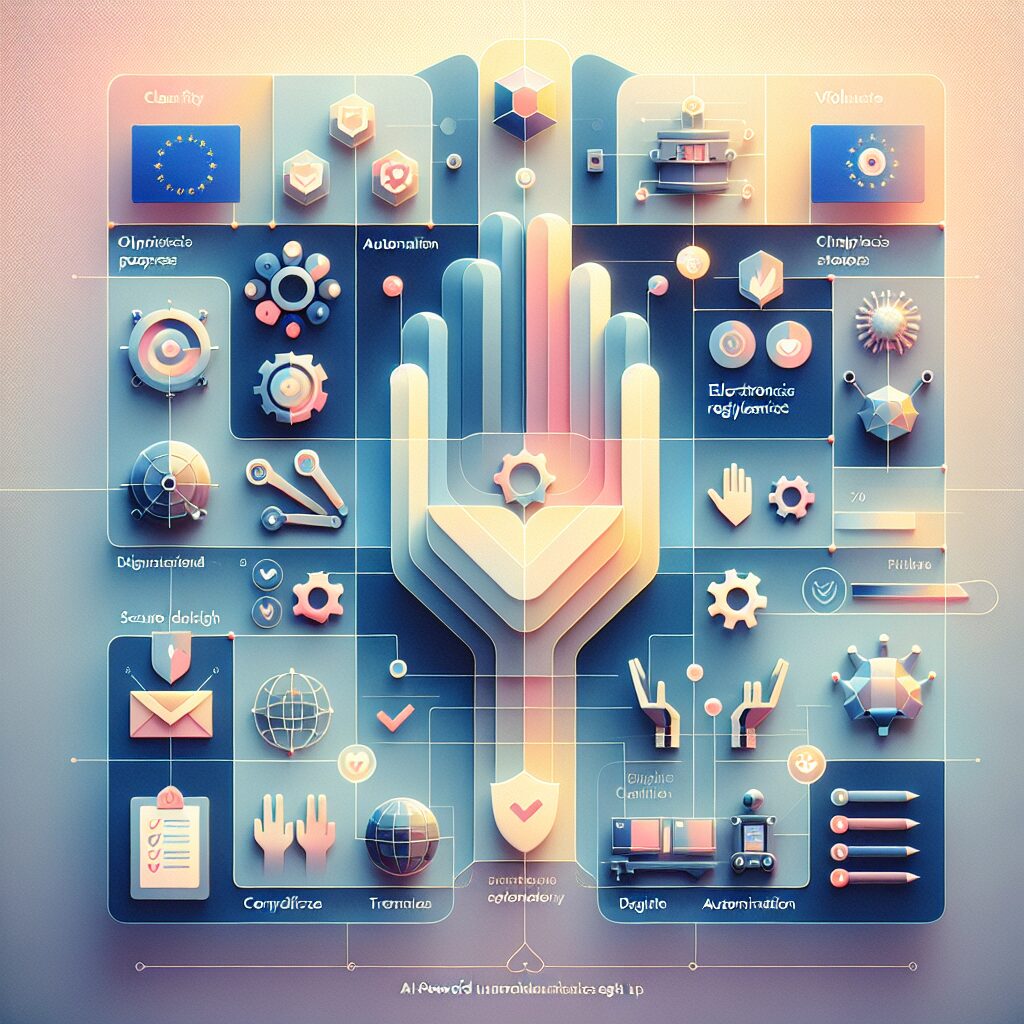About eldris
epr.eldris.ai leads the EPR sector, in fast, automated, AI Agent EU Complaince. LUCID Packaging, WEEE, and Battery Compliance for Brands, E-Commerce and Service based businesses expanding into the EU.
In This Article
- EU WEEE compliance is mandatory for all electronics sellers in the European Union.
- Manual processes are inefficient and error-prone, especially for multi-country operations.
- Automation through epr.eldris.ai streamlines registrations, produces WEEE numbers, and ensures ongoing reporting compliance.
- Each EU country has specific compliance nuances—automation eliminates risks and harmonises submissions.
- Staying compliant as you scale means integrating regulatory tools directly into business operations.
What Is EU WEEE Compliance?
Understanding Your Producer Responsibilities
EU WEEE compliance refers to adherence with the Waste Electrical and Electronic Equipment Directive established by the European Union. This directive places legal obligations on producers, importers, and online retailers of electrical and electronic equipment (EEE) to ensure responsible handling of electronic waste. Businesses that fail to comply can face substantial penalties, along with reputational damage.
The central aim of EU WEEE compliance is environmental: reducing electronic waste and promoting reuse, recycling, and responsible disposal. Whether you’re launching a tech product or reselling consumer electronics throughout Europe, your registration with national registers, EPR schemes, and reporting systems is not optional. It’s mandatory.
As a producer, you must label all eligible products with the crossed-out wheeled bin symbol, register for a national WEEE number, finance the collection and treatment of e-waste, and report periodically on product volume and category. Each EU member state has its own register, which presents further complexity for cross-border sellers.
Failure to comply with these obligations can lead to enforcement actions including bans, penalties, or forced product withdrawals. Therefore, understanding what qualifies as EEE, your specific product categories, and the reporting cadence is absolutely vital to establishing and maintaining EU WEEE compliance.

Why Should You Automate EPR Setup?
Challenges of Manual WEEE Onboarding
Setting up Extended Producer Responsibility (EPR) registrations manually across the EU is a highly fragmented and burdensome process. Businesses must navigate multilingual documents, country-specific legislation, local authorities, and variant product categorisations. For small and medium-sized enterprises (SMEs), this creates an unmanageable administrative load.
Manually submitting documentation to each nation’s WEEE register drains resources. Moreover, the risk of human errors—failing to meet a deadline, misclassifying a product, or providing inadequate documentation—can have serious financial and operational consequences. Compliance officers and e-commerce logistics teams often find this process overwhelming, especially when scaling into multiple markets.
Automating onboarding enables businesses to centralise their data, automate recurring reports, and track obligations in real-time. This not only saves time but also boosts compliance accuracy. With increasing scrutiny from EU regulators and marketplaces enforcing tighter EPR documentation requirements, it’s no longer a strategic option—it’s an operational necessity.
“Without automation, EU WEEE compliance can become a full-time job—especially for sellers operating in more than one EU country.”
How epr.eldris.ai Simplifies WEEE Compliance
epr.eldris.ai is designed to streamline the tedious aspects of EU WEEE compliance through full automation. From initial national registrations to periodic reporting, our platform handles every touchpoint required by regulators. The system uses structured data entry and industry-specific templates that ensure your product information meets harmonised standards across Europe.
Once your product catalogue is onboarded, our localisation algorithm applies the correct taxonomy for each market, highlighting any missing documentation or potential conflicts. Smart validation flags inconsistencies and provides step-by-step guidance for rectifying them. After registration, automatic report scheduling ensures that all monthly, quarterly, or annual obligations are met seamlessly.
For e-commerce sellers and multinationals alike, this reduces compliance costs and internal workload significantly. With robust audit trails, integration with ERP systems, and instant document generation, epr.eldris.ai centralises data and ensures you’re always inspection-ready. The result is continuous compliance without complexity.
Step-by-Step: Automated WEEE Registration
Achieving EU WEEE compliance through automation consists of several key stages, all of which epr.eldris.ai facilitates for you.
1. Product Classification
The first step is correctly categorising each of your SKUs under the proper EU WEEE categories. These definitions can vary by country, but automation ensures the accurate mapping of devices according to technical specifications and use case.
2. National Registration
We submit registration applications to each required national authority. Whether registering in Germany, France or Spain, each body requires slightly different documentation and proof of liability insurance. We handle these nuances automatically.
3. Producer Number Allocation
Once registration is accepted, you receive your WEEE producer number—a critical identifier required for invoices, marketplace compliance and shipments.
4. Reporting Setup
Depending on the market, you’ll need to declare monthly or quarterly sales volumes by product type. epr.eldris.ai extracts this data from your e-commerce systems and pre-fills compliant reports.
5. Ongoing Compliance Monitoring
The system notifies you of upcoming deadlines, changes in legislation, or anomalies in filing. This ensures proactive management rather than reactive panic.
What Is a WEEE Producer Number and How to Get It
A WEEE producer number is a unique identifier that proves your business is registered under national WEEE regulations. It is typically issued by the country’s environmental agency after successful documentation review. This number must appear on invoices and relevant documentation submitted to marketplaces such as Amazon or eBay. Without it, your listings may be removed or refused.
To get your WEEE producer number, you must provide accurate information about your company’s legal structure, products, and distribution channels. Supporting documents such as insurance confirmation, compliance contracts, and VAT registration are also necessary. Automation expedites the identification and submission of these inputs to the correct agencies.
Remember, each WEEE number is country-specific. If you sell in five EU countries, you’ll need five valid producer numbers. epr.eldris.ai maintains centralised dashboards where all your numbers are tracked in one place for seamless management. Learn more about EU Extended Producer Responsibility (EPR) & Compliance Automation
Compliance Across Multiple EU Countries
When your e-commerce or distribution footprint spans multiple EU countries, WEEE compliance becomes considerably more complex. Each state has individual laws transposing the Directive into local legal frameworks—not to mention different reporting thresholds, deadlines, and financial contribution models.
For instance, Germany’s EAR register requires monthly reports, while Sweden mandates quarterly declarations. France interprets EEE categorisation differently from Italy or the Netherlands. Inconsistencies like these make manual, spreadsheet-based compliance unsustainable.
epr.eldris.ai simplifies multi-country compliance by harmonising your product data and formatting submissions in accordance with each country’s requirements. Automatic currency and language localization coupled with real-time updates mean you’ll never miss a change or deadline again. This harmonisation engine is essential for maintaining sustainable growth in diverse European markets. EU guidance on WEEE regulation and obligations
AI and Automation in Reporting and Documentation
AI enhances WEEE regulatory compliance by analysing your sales data, identifying relevant categories, and flagging deviations. Natural language processing scans product descriptions and classifies them correctly under WEEE frameworks. This is vital, especially for organisations with diverse and dynamically changing product portfolios.
Automation ensures data entry accuracy and consistency through template-based input forms, while validation rules catch anomalies in weight calculations or taxonomy selection. Dynamic rulesets adapt to legislative updates—so as regulations change, your reporting changes instantly without manual recalibration.
Periodic reports are generated automatically, cross-checked for completeness, and sent to the relevant registries securely. Templates used for France differ from those used in Austria, and our platform reflects this distinction by default. You benefit from a centralised suite of tools that futureproofs your operations as policymakers update requirements. Read a related article
Common Pitfalls in WEEE Compliance
Mistaking WEEE Scope Eligibility
Many sellers incorrectly assume only large equipment falls under the WEEE scope. In truth, small appliances, digital watches, and electric toothbrushes may all require registration. Not understanding the precise categorisation is a common yet costly error.
Neglecting Re-Registration Requirements
Annual re-registration or fulfilment of documentation deadlines is often missed. Registries may suspend your profile until issues are resolved. A lapse in WEEE credentials can block your operations on some online platforms.
Marketplace De-Listing
Amazon, Zalando, and other leading marketplaces now require valid WEEE registration proof. Failure to provide a recognised WEEE producer number may result in part or full catalogue deactivation. Relying solely on spreadsheets or ad hoc emails for record-keeping is no longer viable.
Best Practices for E-Commerce Sellers
For online sellers, adhering to EU WEEE compliance requires integrating EPR into product management routines. Start by defining clear ownership of compliance tasks—who registers? Who updates reports? Then, ensure your SKUs are categorised properly during onboarding, preferably with automation tools.
Maintain documentation archives for at least 10 years, especially for declarations and invoices linked to WEEE mandates. Integrate compliance modules within your ERP or inventory system to avoid rekeying entries. Most importantly, leverage platforms like epr.eldris.ai to unify and automate compliance reporting. This is especially crucial if your business sells via multiple marketplaces.
How to Stay Compliant as You Scale in the EU
As your product portfolio and market scope expand, so will your regulatory touchpoints. Staying compliant means proactively managing upcoming changes, emerging producer obligations and evolving enforcement intensity.
Using an automated compliance engine prepares your backend for sudden surges in sales or new SKUs by handling added volume and new jurisdictional rules in the background. epr.eldris.ai makes entering a new market merely a configuration update, not a legal nightmare.
Conclusion: Faster, Smarter EPR Onboarding Starts Here
EU WEEE compliance is more than ticking a regulatory box—it’s a cornerstone of sustainable business operations within the EU. Done manually, it becomes cumbersome and potentially risky. Automating your onboarding and compliance through epr.eldris.ai eliminates this friction, enabling you to scale with confidence, accuracy, and full legislative alignment.
Don’t let regulatory complexity stifle growth. With precision onboarding and smart automation, you transform compliance from liability into a competitive edge.
Great guide on eu-weee-compliance-automated-onboarding – Community Feedback
What is required for EU WEEE compliance?
You must register as a WEEE producer, obtain a producer number, report EEE placed on the market, and ensure proper collection, recycling, and documentation per each EU country’s requirements.
How does epr.eldris.ai automate WEEE onboarding?
epr.eldris.ai automates registration, producer number acquisition, and ongoing WEEE reporting using AI-driven workflows, reducing errors and delivering rapid marketplace compliance for your products.
Why is automated EPR essential for EU sellers?
Automated EPR minimises administrative burden, ensures timely compliance, helps avoid regulatory penalties, accelerates product launches, and supports compliance as you scale across European marketplaces.










